|
© Eric R. Pianka Estonian Translation by Sonja Kulmala Macedonian Translation by Jim Anastasovksi The first law "conservation of matter and energy" states that matter and energy cannot be created or destroyed. Matter and energy can be transformed, and energy can be converted from one form into another, but the total of the equivalent amounts of both must always remain constant. Light can be changed into heat, kinetic energy, and/or potential energy. Whenever energy is converted from one form into another, some of it is given off as heat, which is the most random form of energy. Use of any kind of energy produces waste heat. Unless this waste heat can be dissipated, temperature rises. Indeed, the only energy conversion that is 100 percent efficient is conversion to heat, or burning. Aliquots of dried organisms can be burned in "bomb calorimeters" to determine how much energy is stored in their tissues. Energy can be measured in a variety of different units such as ergs and joules, but heat energy or calories is the common denominator.  
A certain amount of solar energy falls on Earth's surface at any given place and time, creating heat. Unless this same amount of heat energy is dissipated back out into space, Earth will warm. Conversely, if more heat is re-radiated back out into space than is received, the planet cools down. Earth's atmosphere used to be in a complex equilibrium. Certain gases in the atmosphere, especially carbon dioxide, prevent re-radiation of longer infrared wavelengths generated by incident solar radiation, holding heat in thus warming the planet (the "greenhouse effect"). The concentration of carbon dioxide has risen steadily over the last 40 years and continues to rise due to deforestation and burning of fossil fuels. This increase in atmospheric carbon dioxide has enhanced atmospheric heat retention and would have produced global warming sooner except for a fortuitous spin-off of atmospheric pollution -- from 1940-1970, particulate matter increased earth's albedo (reflectance of solar irradiation), allowing less solar energy to penetrate to the surface (volcanic ash in the atmosphere has the same effect). Fortuitously, these two opposing phenomena balanced one another for three decades, but the balance shifted about 1970 and the enhanced "greenhouse effect" is now leading to rapid global warming (Domino Effects). 
Long-held meteorological records the world over have been broken regularly during the last couple of decades. The continent of Australia has been hit hardest (link), with its eastern two thirds experiencing a great decrease in precipitation over the past four decades (map). 

Until recently, Earth was in a delicate thermal balance with heat gained approximately equal to heat lost, cycling within a fairly narrow range as glaciation produced cooling and deglaciation produced warming with a periodicity of roughly 100,000+ years (see methane graph below). But now, due to burning fossil fuels over the last century, humans have increased carbon dioxide levels, which in turn have enhanced the greenhouse effect and prolonged the present deglaciation/warming trend for the last 10,000 years, whereas former warm peaks in the cycle were much shorter (again, see the graph below). Holding in more solar energy has lengthened the period of global warming. This latest warm period extends for about 100 centuries and is called "the long summer" (Fagan 2004). Recently, Ruddiman has proposed that human activities,  primarily deforestation, began to alter atmospheric carbon dioxide and methane levels
many centuries ago, long before the industrial revolution. If so, global warming may not be
a recent development but may have begun nearly 100 centuries ago with the advent of agriculture.
The figure at the left shows how rapid and complete deforestation has been in the United States.
The figure below shows
Nordell and Gervet's (2009) estimates of how much anthropogenic heat emissions have
contributed to present day global warming.
primarily deforestation, began to alter atmospheric carbon dioxide and methane levels
many centuries ago, long before the industrial revolution. If so, global warming may not be
a recent development but may have begun nearly 100 centuries ago with the advent of agriculture.
The figure at the left shows how rapid and complete deforestation has been in the United States.
The figure below shows
Nordell and Gervet's (2009) estimates of how much anthropogenic heat emissions have
contributed to present day global warming.

Even if humans were not adding vast amounts of excess heat by burning non-renewable fossil fuels and running nuclear reactors, the planet no longer can dissipate the heat it receives from normal incident solar radiation fast enough to stay in balance (Hansen et al. 2005). Many people naively think that access to more and more energy will somehow 'solve the energy crisis.' In fact, to stop global warming and return the Earth back into its normal thermal cycle, we would need to greatly reduce our energy usage. It might be nice if somehow we could also scrub some carbon dioxide out of the atmosphere, as that would increase the capacity for heat dissipation thus allowing us to use more energy without global warming. Unfortunately, this is a pipedream, because cleaning many gigatons of carbon dioxide out of the atmosphere isn't really energetically feasible. We may well have already reached the point of no return. Weather is driven by the thermal differential between the surface and atmosphere versus that of outer space, which remains cold and constant. As Earth warms, this energy gradient increases and climate goes into convulsions -- droughts and heat spells are intensified and storms become more intense. With the melting of glaciers and ice caps (see below), more water enters the atmosphere, changing the hydrological cycle. Ice is white and reflects solar energy whereas darker open water absorbs it, producing a powerful positive feedback loop that continually enhances global warming. We can expect more flooding, more tornados, bigger and more frequent hurricanes and monsoons. Weather is rapidly becoming more variable and more extreme. The exact timetable for these changes is uncertain, but data and current events suggest that climate changes have taken place during human lifetimes. A tipping point, or point of no return, may well have already been reached (see below). Despite cries that climate change is not occurring, usually supported by parties with serious conflicts of interest [such as pseudo-scientists for sale under the payroll of big oil and the Heartland Institute (a proxy for the Koch brothers and big oil)], evidence for global warming is unequivocal (for further documentation and expert opinion, see also links provided below). For example, watch this NASA video showing average temperatures over the course of the past 128 years or study the following two graphs of long-term climate change from the National Oceanic and Atmospheric Administration. 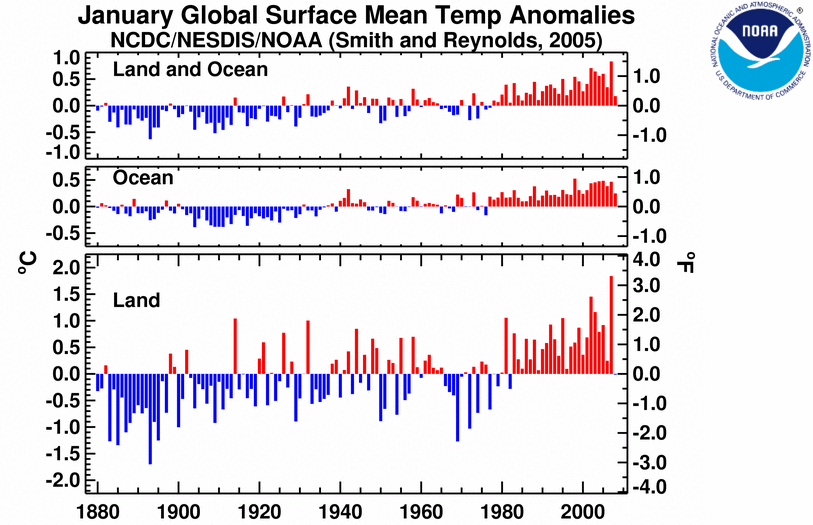
Notice that land masses began to warm before the oceans and that land temperatures have increased more than those of the oceans. Water has a high specific heat, which means that a considerable amount of heat energy is required to raise its temperature -- indeed the oceans have acted as a heat sink which has kept land temperatures from rising as much as they would have without the large bodies of water. The high specific heat of water has thus helped to moderate the increased heat load to some extent, but has resulted in the world's oceans warming by nearly a full degree Celsius over the past half Century. Warmer ocean waters are now rapidly melting Antarctic sea ice sheets from the bottom sides (Oceans). 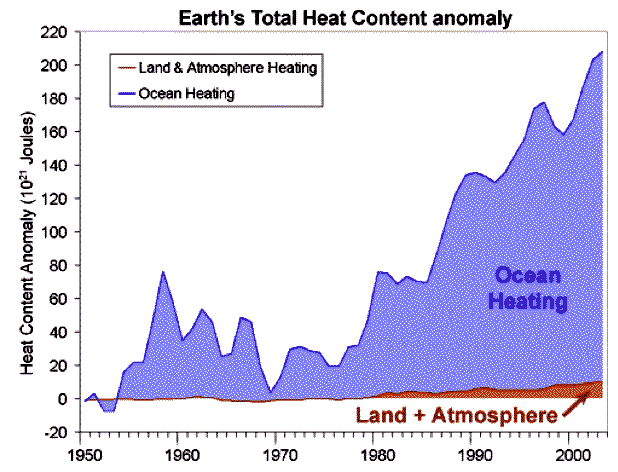
The oceans also absorb carbon dioxide, forming carbonic acid, which leads to acidification. The combination of oceans warming and acidifying has caused endosymbiotic coral zooxanthellae to die off (so called "bleaching of coral reefs"). We have also over harvested marine fish and mammal stocks and marine ecosystems are on the verge of collapse (Domino Effects). Together, the oceans and the atmosphere control climate. Ocean currents act as conveyor belts moving heat away from the equator. Changes in ocean currents have had drastic impacts on past climates and are likely to do so again in the future. Warming of surface seawaters could change ocean currents, even disrupting heat pumps such as those that keep northern Europe warm. Average global temperatures of both land and oceans have been above average every year for the past 25 years, a clear indication that climate changes are taking place during human lifetimes. 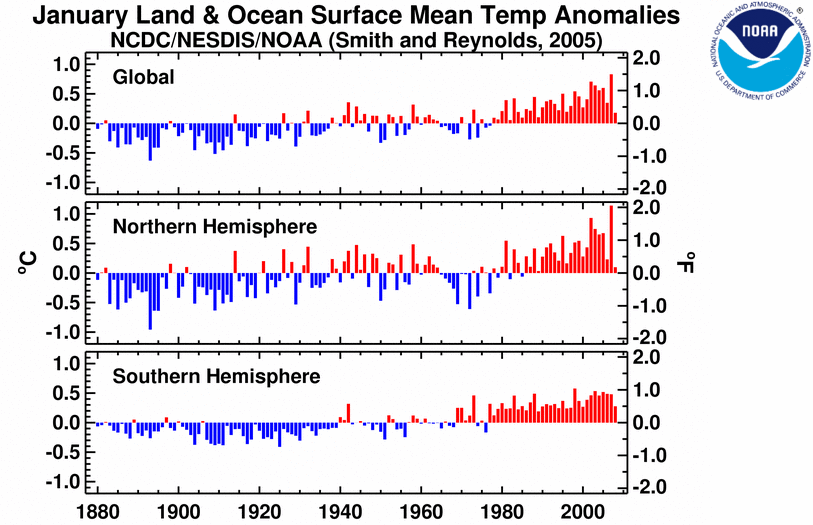
Another way to show climate change is to plot year-to-year deviations from long-term average annual temperature over the course of the past century (blue dots in graph below). The red curve represents a 5-year moving average.  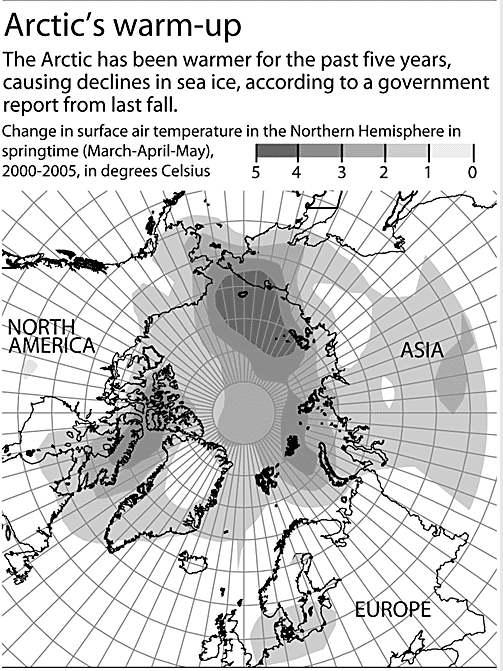
Everyone should be familiar with the increasing carbon dioxide levels in the atmosphere due to human activities, especially burning of fossil fuels. People are less familiar with the recent surge in methane levels (see graph below). Like carbon dioxide, methane is a greenhouse gas which holds in heat. One molecule of methane is equivalent to about 25 molecules of carbon dioxide in terms of its effects on global warming. When a molecule of methane burns, it gives off heat and is oxidized into 2 molecules of water and one of carbon dioxide, both of which are powerful greenhouse gases. Long frozen fossil methane is being released from thawing permafrost and from the deep oceans at an ever accelerating rate. As temperatures rise, more methane bubbles up to the surface, further raising temperatures in an ever increasing positive feedback loop. Is there a critical "tipping point" at which the state of Earth's surface will change drastically, and if, so, what is it and when will it be reached? Some experts think this tipping point has already been crossed. Major methane vents are shown on the following map. Methane levels in the atmosphere are now more than double the levels that they have been over the last half million years (see graph below). This could well portend the onset of a powerful positive feedback loop that will almost certainly lead to very rapid global warming. 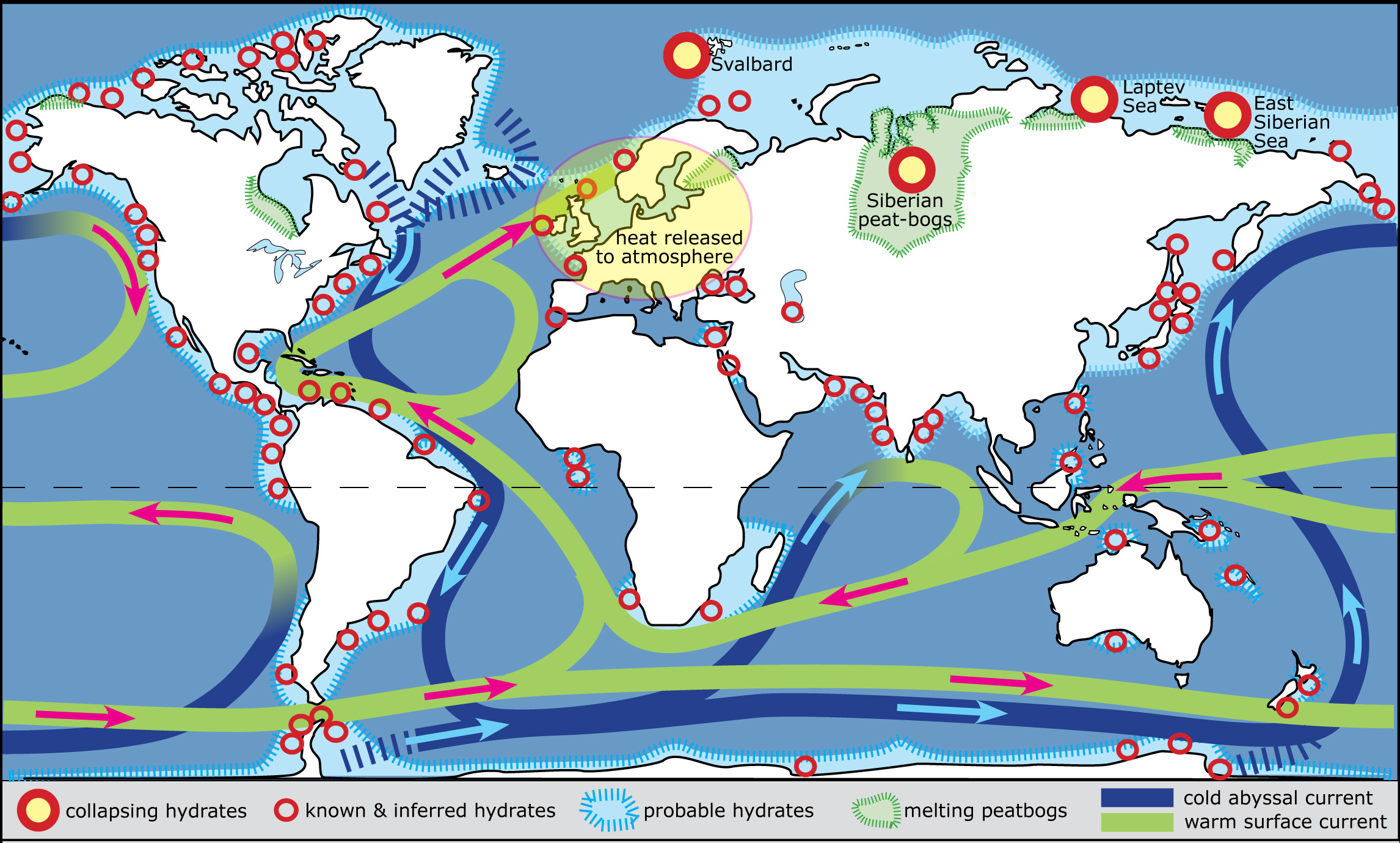
Methanogenic bacteria survive today in anaerobic zones deep in Earth's crust and in the ocean depths. Vast amounts of methane are locked up inside ice-like frozen clathrates in permafrost and the ocean depths. When these clathrates are brought to the surface, methane gas is released. The sudden release of large amounts of gaseous methane from long frozen methane clathrates has sometimes been implicated in the major extinction event at the Permian-Triassic boundary 250 mya (NASA's Gavin Schmidt on Methane and rapid climate change). As many as 96% of all marine species and 70% of terrestrial vertebrates died out then. More than half of the then extant insect families also perished. Coupled with massive volcanic events, sudden release of large amounts of methane into the atmosphere caused drastic climatic changes, anoxia, increasing aridity, and changes in ocean current circulation patterns. Fungi are thought to have flourished during this period, probably because they consumed much of the dead organic matter. We should be doing everything we can to KEEP this methane locked up in Earth's crust and frozen in the deep oceans. However, people seem to think we can live above the laws of nature and can use all the energy we "need" and want. Fracking cracks deep rocks releasing methane produced by anaerobes much of which vents to the surface and enters the atmosphere. 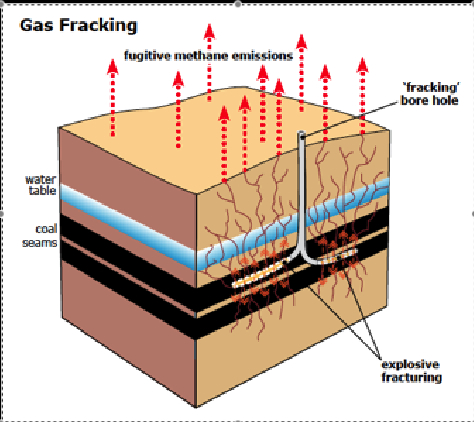 We are also deliberately extracting methane from ocean clathrates and BURNING it
for energy. Both fracking and clathrate mining release a lot of waste heat that
cannot be dissipated as well as adding more water vapor and carbon dioxide to the
atmosphere, further speeding up the rate of global warming. An international consortium involving
Canada, the US, Japan, India, and Germany is already extracting methane from
clathrates and burning deep sea methane off the north coast of Canada at
a place called Mallik. The USGS has nine other similar
projects underway
scattered around the world. Our voracious appetite for ever more and more energy accelerates
the rate of
global warming.
These ill-fated efforts to use methane as fuel will only hasten climate change.
What fools we humans are, rushing to destroy this, our one and only
Spaceship Earth!
We are also deliberately extracting methane from ocean clathrates and BURNING it
for energy. Both fracking and clathrate mining release a lot of waste heat that
cannot be dissipated as well as adding more water vapor and carbon dioxide to the
atmosphere, further speeding up the rate of global warming. An international consortium involving
Canada, the US, Japan, India, and Germany is already extracting methane from
clathrates and burning deep sea methane off the north coast of Canada at
a place called Mallik. The USGS has nine other similar
projects underway
scattered around the world. Our voracious appetite for ever more and more energy accelerates
the rate of
global warming.
These ill-fated efforts to use methane as fuel will only hasten climate change.
What fools we humans are, rushing to destroy this, our one and only
Spaceship Earth!
Four prolonged ice ages are clearly evident. Notice the four spikes in temperature spaced roughly every 100,000+ years. Earth is presently in a warm interglacial phase with CO2 and methane levels well above any that have been experienced during the last 400,000 years. Notice also that the last thermal spike has been prolonged a lot longer than the three earlier ones. Earth should have gone into a colder glacial state but has stayed warm for roughly the last 10,000 years ("the Long Summer"). This extended warm period corresponds to the invention of agriculture and the resulting surge in human population and it is almost certainly due to human activities, especially deforestation and burning of fossil fuels (see also this link). Notice also the very recent, exceedingly steep, spike in methane production! Methane concentrations in Earth's atmosphere are rising rapidly and the situation has recently become quite dire, especially in the northern hemisphere where burgeoning human populations are burning massive amounts of fossil fuels. 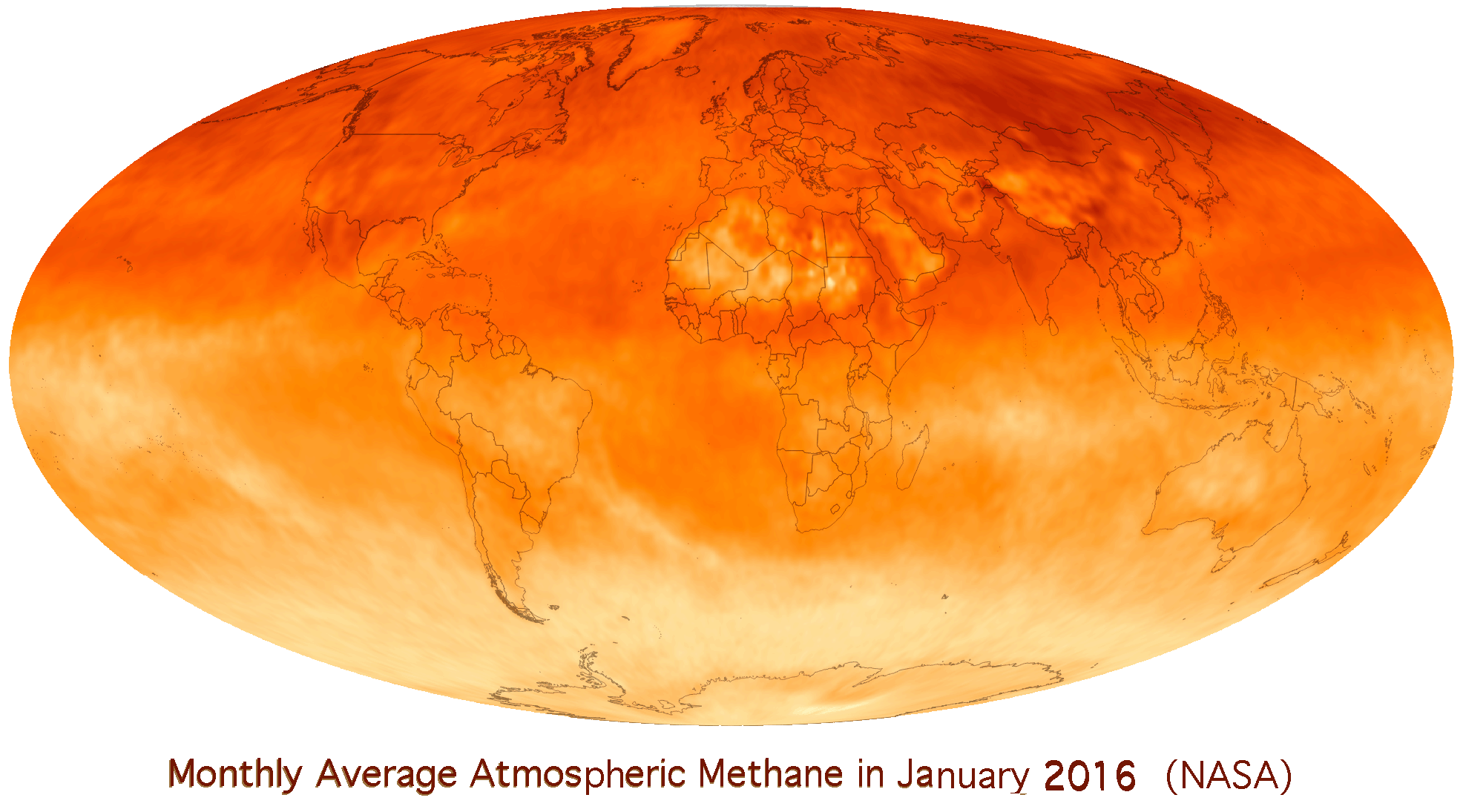

Sea levels have risen almost a foot during the last century. Some experts think that eventually all Earth's glaciers will melt and that sea levels will be substantially higher, inundating all major coastal cities. One very large Antarctic glacier, currently on land, is melting and as its melt water lubricates its underside, it is sliding towards the sea at an accelerating rate, currently about 3.5 km per year, hardly a glacial slow speed. Remember "the tip of the iceberg" (90% is underwater)? When that huge glacier finally plunges into the ocean, sea levels will rise almost instantly all around the world, inundating low-lying coastal areas. Talk about a tipping point!  
Another very dangerous man-made molecule, trifluoromethyl sulfur pentafluoride SF5CF3, has recently begun to appear in the atmosphere. Each molecule of this greenhouse gas has 18,000 times the effect of one molecule of carbon dioxide on heat retention. Although SF5CF3 is present in very small amounts, it is exceedingly stable (half life=1000 years) and is increasing at a rate of about 6% per year [Sturges et al (2000) Science 289:611-613]. Scientists have recently discovered correlations between climate change and geological activity, and have suggested that earthquakes and volcanos could result from rapid climatic forcing (link). Strong earthquakes do appear to have increased in frequency during the last couple decades. 
Of course, we humans are clever, so clever that we have actually figured out how to convert matter into energy exploiting fission and fusion. Physicists have recently proposed using fusion and fission to clean up radioactive waste products, but this process would release vast amounts of heat into an already overloaded system. Some NASA engineers are also proposing to beam more solar energy from outer space to the planet's surface. A Japanese company is actually proposing to capture solar energy on the moon and transmit it to Earth. Such people think that we can use all the energy we want or can get in any way we want. Nuclear energy is virtually limitless, but it carries serious environmental hazards (particularly thermal pollution and radioactive waste). Access to such excess energy will lead to our downfall (see below). Unlimited cheap clean energy, such as that so ardently hoped for in the concept of cold fusion, would actually be one of the worst things that could possibly befall humanity. Such energy would enable massive energy consumption and habitat destruction. Mountains would be leveled and terraced, massive water canals would be dug, ocean water distilled, water would be pumped and deserts turned into green fields of crops. Human populations would grow even higher until the last vestiges of natural habitats are all destroyed. Heat dissipation will ultimately dictate limits, for when more heat is produced than can be dissipated, the resulting thermal pollution will quickly warm the planet to the point that all life is threatened, the ultimate ecocatastrophe. In fact, this scenario is already happening even as many people remain locked in denial, steadfastly refusing to admit that a crisis even exists. 
(source: http://www.submedia.tv/endciv-2011/) The world's human population of almost 8 billion (that's 8,000 Million!) is increasingly destructive in its various 'constructive' economic enterprises, whose goal is growth and development, which convert huge amounts of energy into heat and waste products. Winston Churchill once said "Men occasionally stumble on to the truth, but most of them pick themselves up and hurry off as if nothing had happened." To keep spirits up, politicians invent irrational expressions like "foreseeable future" or "sustainable growth" and "sustainable development." People do not analyze these expressions, but prefer blissful ignorance vis-a-vis their meaning. However, stringing such antonyms together merely creates irresponsible oxymorons. Physical laws of nature will go on about their business of running the Universe, while most people remain oblivious to the impending emergency we have caused. We are rapidly destroying our own life support systems on this, our one and only Spaceship Earth. We are Earthlings, but very selfish ones, as we think nothing of taking resources and habitats away from all other Earthlings. Remember that ancient Chinese curse: "may you live in interesting times"? You lucked out, for right now is undoubtedly the most interesting time in the entire history of humanity. Not only do we get to face population overshoot, but also all of its many consequences: ferocious weather, crop failures, energy shortages, shortages of food and water, economic collapse, toxic wastes, pollution of our air and water, anarchy, famine, pestilence, war, loss of biodiversity, the devaluation of human life, not to mention the impending demise of civilization and the loss of human knowledge. Watch Newsroom: Climatologist Interviewed Watch Arctic Methane Emergency: Economy vs. Ecology Links: 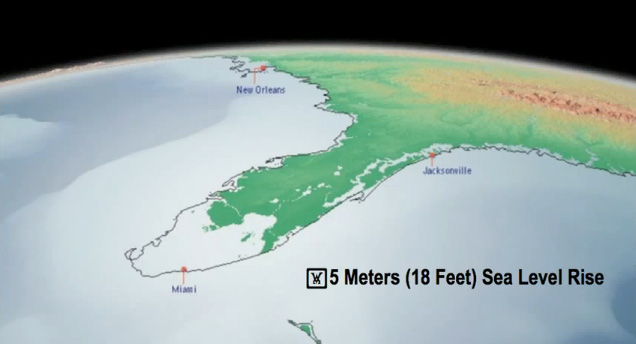
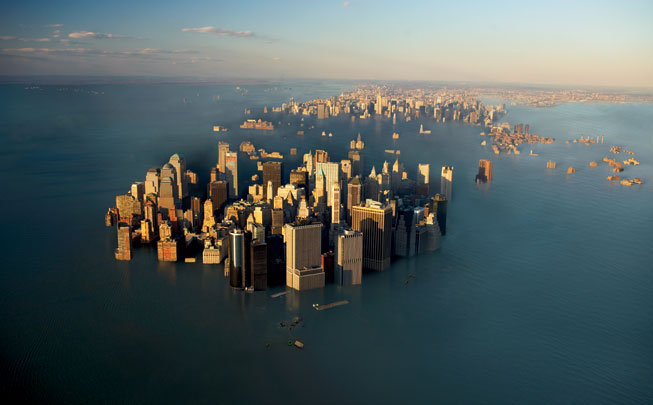
|
Last updated 11 January 2017 by Eric R. Pianka
web counter